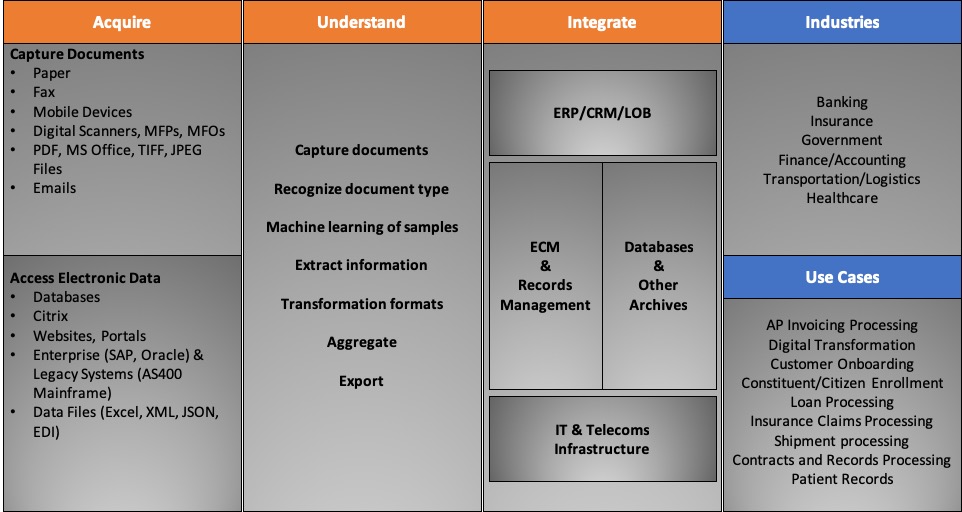Cognitive Capture
Use AI to turn documents and data into savings and simplicity.
Cognitive Document Automation
Document-based tasks are both time-consuming and costly. Organizations with document-intensive processes struggle to tame high volumes of paper and electronic documents, multiple disparet communication channels, manual repetitive processing steps, and hard-to-integrate backend systems. These challenges reduce information visibility and enterprise agility, swell operational costs, and slow customer response and resolution times. Businesses also struggle to keep up with government and industry regulations due to lack of control and visibility over each step of their business processes.
Derobia has the knowledge to implement CDA process intensive solutions. Organizations want to make these document-based processes more efficient by automating the acquisition, understanding and integration of the documents and information contained in them. Cognitive document automation (CDA) software uses artificial intelligence to make this a reality.
The Intelligence of CDA
CDA encompass three process stages: Acquire, Understand, and Integrate. CDA can acquire documents and electronic data from numerous sources; extract, aggregate and transform this data; and deliver the transformed data to the systems and processes that require it.
Acquire
This step involves acquiring documents from common channels, formats and devices including email, fax, folder, PDF and Office files, website uploads, MFPs, scanners and mobile devices. Customers expect the document submission process to be smart enough to allow use of different channels at different times during the same process – without having to adjust to different instructions, re-submit or start over. Mobile apps and capture-enabled websites should include embedded document capture capabilities that enable real-time capture and data display and the ability for users to correct data before submitting.
Understand
Once a document is acquired, CDA answers the following questions: What is this document or email about? What information does it contain? What should be done with the document and the information? This step involves the cognitive transforming of documents and document data into intelligent, business-consumable content required by downstream processes and systems.
Integrate
In the Integrate step, CDA integrates with downstream processes or systems of record through either pre-configured system-specific connectors or API or standards based connectors. CDA can also leverate RPA robots to integrate with systems where these connectors are unavailable. In this case, RPA employs built-in integration capabilities that easily map data between source and destination systems, without the need for exposed APIs or web services and without writing integration code.

Must-Have CDA Capabilities
- Distributed document capture (at field/branch offices)
- Multi-channel capture (mobile, email, web, fax, desktop scanner, folder and MFP front-panel integration
- Mailroom capture (from multiple departments) for a fully comprehensive digital mailroom
- Automated document classification for any type of document
- Automated separation from a batch of documents
- Data extraction from all types of forms with all types of fields, from structured forms to unstructured documents
- Intuitive and keyboard-friendly data validation that supports validation rules and database matching
- Machine learning of documents and data to train the system, and to learn from production user input
- Natural language processing of emails and other unstructured content
- Document and data exports and integration to systems of record, without needing integration code (often using RPA)
- Process intelligence to identify automation opportunities and track CDA performance
- Project customization by adding (and debugging) script
- Integration with RPA and BPM/DCM to handle business rules, user forms and exception handling capabilities
Measuring Success
The objective of any CDA project is to realize the expected benefits of greater visibility, lower costs, faster processes, fewer errors and improved customer engagement. This can be determined by looking at:
- OCR accuracy
- User efficiency
- User productivity
When configured effectively, CDA solutions will deliver an attractive ROI and payback, frequently achieved between 6 and 18 months from system launch.
We can offer different process improvement possibilities with Kofax provided solutions. Contact us for further details.
Cognitive Document Automation
It’s not just about OCR
An Overview
Interested in learning more about how CDA works?
